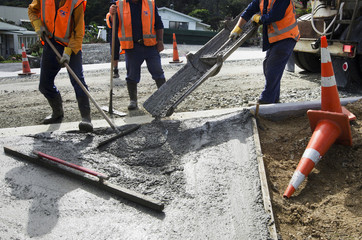Before attempting any concrete repair, it is imperative to prepare the area properly. Small areas of crumbling concrete can be removed using a heavy-duty trowel, while larger cracks may require a cold chisel. After removing loose edges and removing debris, hose the area down to a solid base. Once the concrete is thoroughly dry, apply the concrete repair material. In most cases, the entire repair process takes only a few hours.

A more advanced approach involves repairing major defects. For this, you must perform the same preparation, material selection, and workmanship as you would for minor defects. A qualified person must properly analyze the problem and document a written repair procedure. Most major defects require outside approval before repair work can begin. The repaired area must be acceptable to the agency that approved it. Concrete Companies should inspect the repair area regularly before starting. And they must document the entire process.
The damaged concrete is removed and replaced with fresh concrete in full-depth repairs. Partial-depth repairs require cutting around damaged concrete and cleaning it. Some repair techniques require the use of epoxy-based mortars and polymer-modified cements. In general, both methods will require some form of a primer, acid etching, and silica to prevent deterioration. For a complete repair, a contractor will use these methods.
The repair process must begin by wetting the area to be repaired. A damp burlap sheet or plastic sheet can be used to prevent moisture from escaping. Then, the area should be allowed to dry for several days before applying the new repair material. A long, moist curing period reduces the likelihood of spalling, cracking, or delamination. The thickness of the repair material will determine how large the aggregates need to be.
The repair process is the most difficult phase of the project, so it is important to prepare the area before applying the concrete thoroughly. Whether the repair is for a minor or major defect, follow a specific procedure. The procedure should be performed by a qualified professional to judge the severity of the damage. This person should have extensive knowledge about the product and its environment. Then, they can decide on the most appropriate method of repair. You can also consult a concrete repair manual for more information.
In addition to the size of the crack, you should also choose the type of reinforcement. A hand tool or concrete saw should be used to open the cracks. If the repair is structural, you should choose epoxy injection, which can either weld cracks together or restore the concrete’s strength. If structural bonding is not desired, urethane sealant can be used for a watertight seal but does not form a structural bond.
Many types of concrete repair materials exhibit inconsistent performance. This is due in part to the fact that these materials lack the ability to bond properly with the concrete substrate. Their brittle nature further compounds this lack of durability. During a Pull-off test, the bond strength of a concrete repair material was assessed. The substrate was prepared using 20 MPa compressive strength, and a geopolymer mortar layer was then cast over it and cut through with a circular hole. The metallic discs were then glued onto the geopolymer mortar.
The minimum size of the crack that requires repair is a quarter-inch. Smaller cracks, however, can be difficult to repair. Frequently, cracks are not so deep that a layer of sand is sufficient to cover the crack. However, if the crack is deeper, you can use sand to fill in the crack. Then, use the appropriate crack sealant to repair the area. The crack may be deep enough to require replacement, but a leveling process is far more affordable than this.
If the crack is shallow and uncomplicated, a DIY method may be sufficient. A standard concrete repair product, such as a self-bonding cement mix, is formulated to fill medium-to-large cracks and voids. This product is available in tubs and 40-pound bags. The recommended amount is one-sixteenth of an inch, and it is a self-bonding material. Once applied, water is needed to bond the product to the concrete.